
Wandsworth Common: from the manor to the people
This series of blogs in our From The Archives series is intended as a resource for schools and local residents who are interested in researching local history.We are very happy to help schools with access to relevant materials. However, the images that are reproduced here should be assumed to be the copyright and may not be reproduced without license from the archives and commercial use is therefore strictly prohibited.
Wandsworth Common itself
Having failed to pass a private bill in 1828 to enclose his lands on Wandsworth & Battersea Common. The Earl Spencer started a process of major land sales in the 1830’s and 1840’s that included the Wimbledon Park Estate. This must have been highly frustrating for Earl Spencer seeing that the land was of significantly increasingly value as London rapidly developed: possibly seeking to emulate The Grosvenor and Bedford Estates‘ considerable successes. Heavy debts forced these land sales.
It is however, worth pausing for a moment to ask if there is an alternative view as to why Earl Spencer had wanted to enclose the common lands? The common was being used increasingly as a rubbish tip and for commoners to extract more and more gravel. So there was a vociferous group who were petitioning the Lord of the Manor, one Earl Spencer, to do something about it. The problem was that without enclosure there wasn’t much Earl Spencer could really do. Enclosure and policing that, with the necessary manpower, was going to cost a lot of money. So the not unreasonable question [putting words into the Earl’s mouth] was, ‘what is in it for me?’
Whatever the truth of the matter was, further attempts at a progressive enclosure of the common lands did not go down very well with the locals, who depended on it for gazing their cattle and other agricultural functions. And so the locals objected, organised by John Buckmaster [c1820-1908]. This included the formation of a committee and the printing and distribution of plenty of flyers and pamphlets!
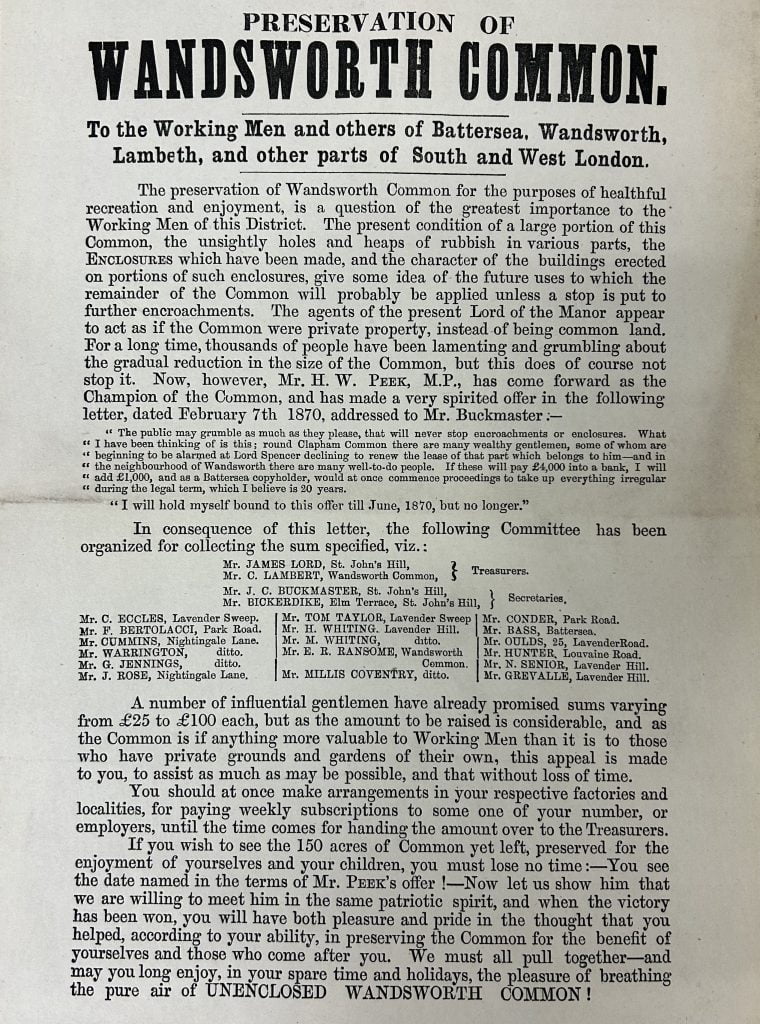
In reality the greatest areas actually lost to Wandsworth Common were from the railway construction. These acquisitions were by various Acts of Parliament, with some compulsorily purchased. It was certainly the case that The Crystal Palace Railway took far more land than it needed as it then promptly sold the excess off to form Chivalry Road and its environs.
All Farthing Piece, which became The Toast Rack, was actually enclosed in 1810. This is contrary to the popular belief and mythology that it was enclosed in 1822 which is definitively erroneous. That date is well before Earl Spencer owned those lands so it is somewhat unfair to lay this at the Earl’s door as the party to the deed was Pierce Walsh Porter. We can state this with absolute certainty as a deed of release, reproduced below, is in preserved in the Magdalen College, Oxford archives and it grants the release from common lands and furthermore specifically names All Farthing Piece. Open the full multi page PDF here.

Could the idea that All Farthing Piece was enclosed in 1822 might well have been propagated as something further to blacken Buckmaster’s Bogeyman-in-chief: Earl Spencer?
Buckmaster successfully organised demonstrations and meetings, as well as a letter writing campaign and a petition to Earl Spencer. These fell on deaf ears.
There was a debate in The House of Commons, on 21st February 1865, reported in Hansard. Various bills were read and withdrawn and we can see by the very fact that it took the best part of six years to pass the bill that it was a tortured process.Wandsworth Common Bill – Select Committee – Friday 21st April 1871 – Morning Session OCR.
A committee was formed on or about 14th March 1870 to raise £4,000 from local people to augment the £1,000 that had been put up by H. W. Peek MP. Open the full multi page PDF here.
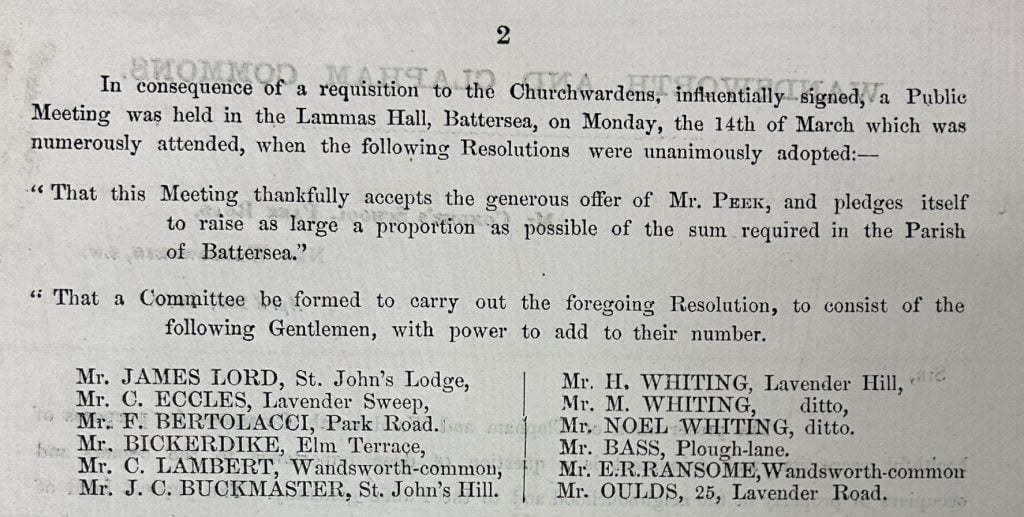
Funding was raised quite rapidly by subscription. If you click on the image below it opens into a PDF of various surviving subscription lists. Open the full multi page PDF here.
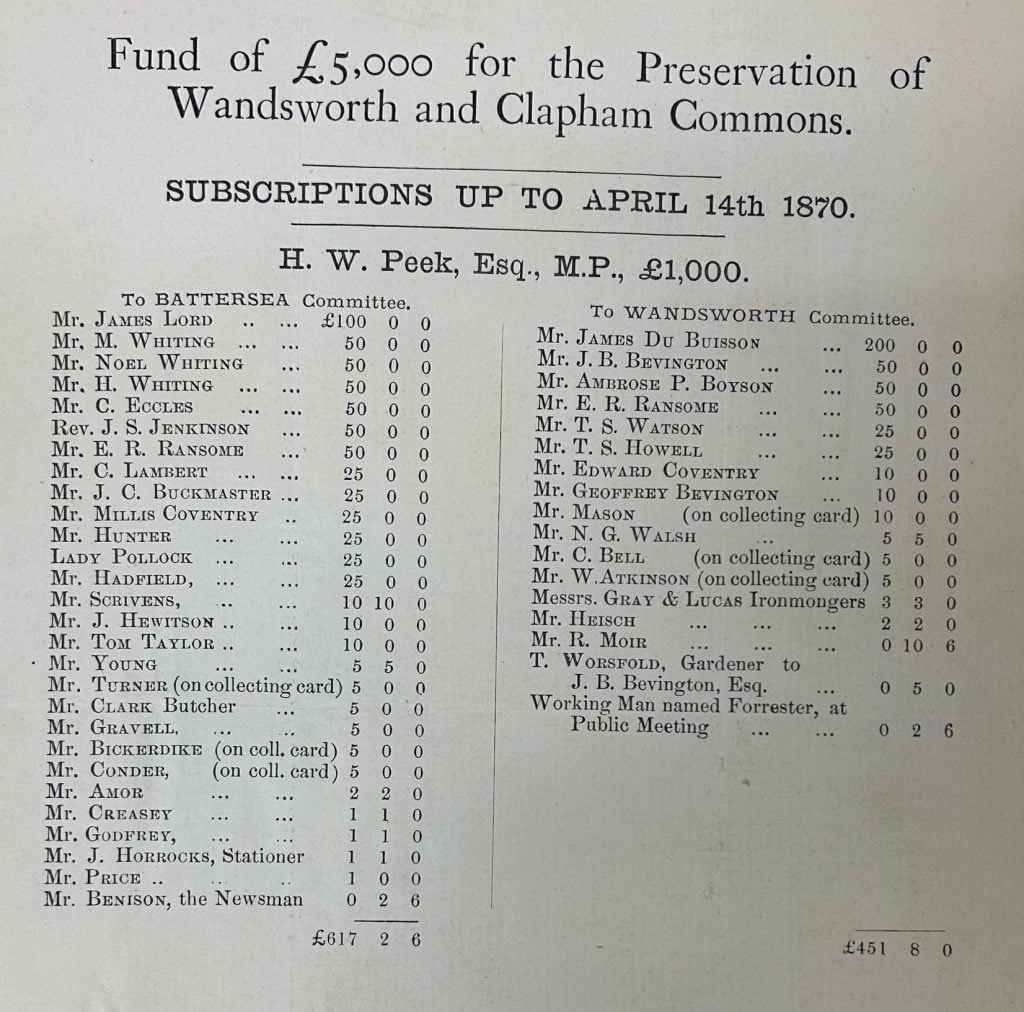
Earl Spencer could probably sensed that this was an increasingly serious issue that needed to be resolved without a tussle that he probably had little appetite for.
Then an amicable resolution was arrived at by the Committee and Earl Spencer. It is dated 22nd October – presumably 1870. Open the full multi page PDF here.
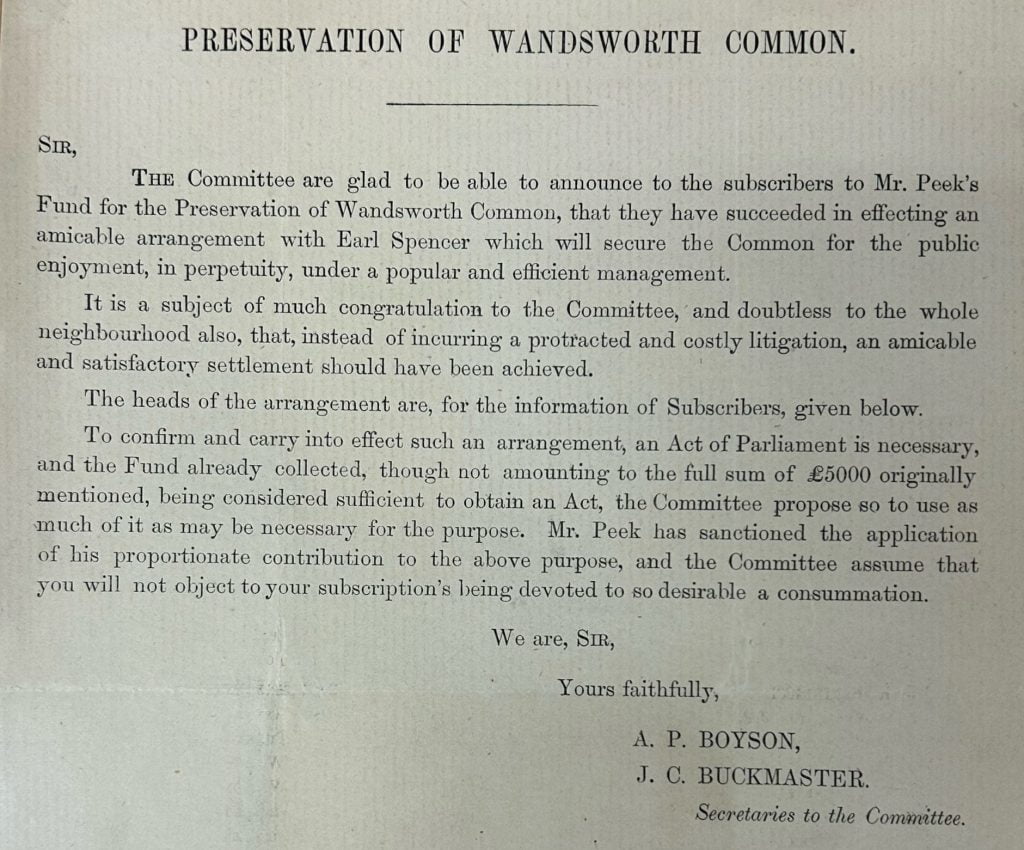
Wandsworth Board of Works were not delighted by this turn of events preferring to keep things simple and to maintain the existing duopoly with the Metropolitan Board of Works.

Meanwhile this was not going down well with the unelected Metropolitan Board of Works who were getting increasingly controlling of all things London and were keen to put a spanner in the works and get control of the Common for themselves.

By 10th March 1871 the bill was advancing through the legislative process and shortly after MBW were discussing the serious matter of making ‘drawing with crayons on the pavement’ (a penal offence under an unspecified Buildings Bill) attention turned to scuppering the 1871 Wandsworth Common Bill.
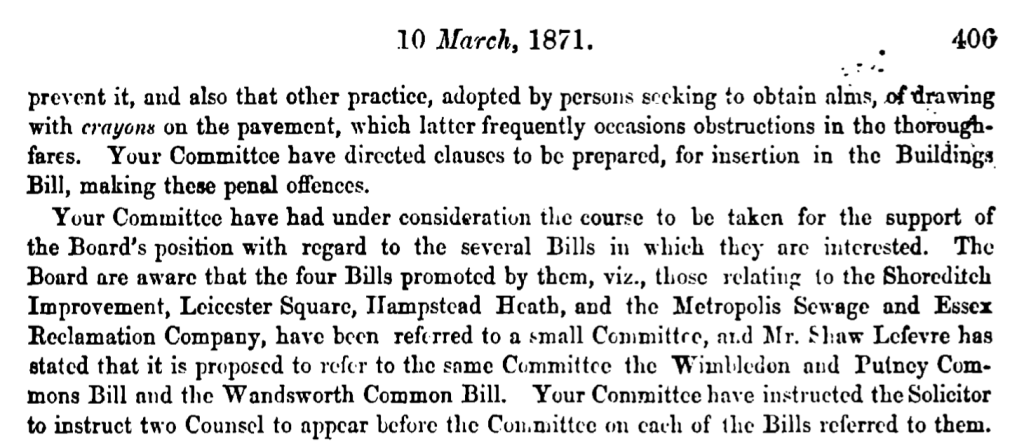
In a series of hearings a select committee heard evidence from various witnesses in two session on 21st April 1871. Morning session here opens as PDF in a new window. Afternoon session here opens as PDF in a new window.
A bill, as amended in committee, was then sent to Parliament.
So, the 1871 Wimbledon and Wandsworth Commons Act was passed by Parliament which transferred the Common from Earl Spencer to public ownership. This was in return for Earl Spencer receiving permission to enclose and develop the lands know as The Black Sea – which was a large gravel pit, which formed a natural lake, where Spencer Park is now.
The House of Commons demanded an account from The Metropolitan Board of Works as to how much money they had spent opposing the bill. It is signed by the Clerk of House of Commons one Erskine May who gives his name to what is often known as the bible of parliamentary procedure.

The history and antics of John Buckmaster need to be taken with a fair pinch of salt. A few of the stores may even be true. One often recounted tale is that Buckmaster got a witness drunk and then got him to sign a statement concerning his grazing activities on Wandsworth Common. Under cross examination the witness admitted to this – more than somewhat derailing the resultant court case.
Under the 1871 Act, the common was then managed by a group of eight conservators for the next 16 years beginning the process of managing the common lands for general public benefit.
There is a copy of the map that accompanied the 1871 Wandsworth Common Bill [described in the bill, paragraph 20, as ‘a duplicate whereof is intended to be deposited with the Clerk of the Peace for the County of Surrey’] held at the London Metropolitan Archives [SC/PM/MB/01/27/019] special collections.

An interesting map survives in the Wandsworth Heritage Archive [there are copies in LMA, Magdalen College, Oxford and Northampton Archives] entitled ‘Wandsworth Common As It Was And Is’ – possibly 1889 – ascribed, by some authorities, to John Buckmaster although this appears a little tenuous. The map has a descriptive key against each numbered area. If you click on the map, below, it opens up into a PDF with the key and annotations.
The map actually has been very heavily ‘updated’ with houses and roads simply drawn on top of trees etc. For instance, look at The Toast Rack area.
The printed caption on the map states that the map is “Photographed from the (6-inch) Ordnance survey taken ins 1866-70 and corrected down to date.” This is simply not correct as simple visual inspection of the full set of OS Maps held online in The National Library of Scotland shows that this is a marked up version of the 6″ Middlesex Sheet XXI Surveyed: 1865 to 1866, Published: 1873
However, the Wandsworth Common ‘As It Was And Is’ map crosses an OS sheet boundary which means that this was likely taken from a special printing of the map. Or that the whole thing has been traced and reproduced by a draughtsman manually. The general impression of the original is that it is not a printed OS map. Open full multi page PDF here.
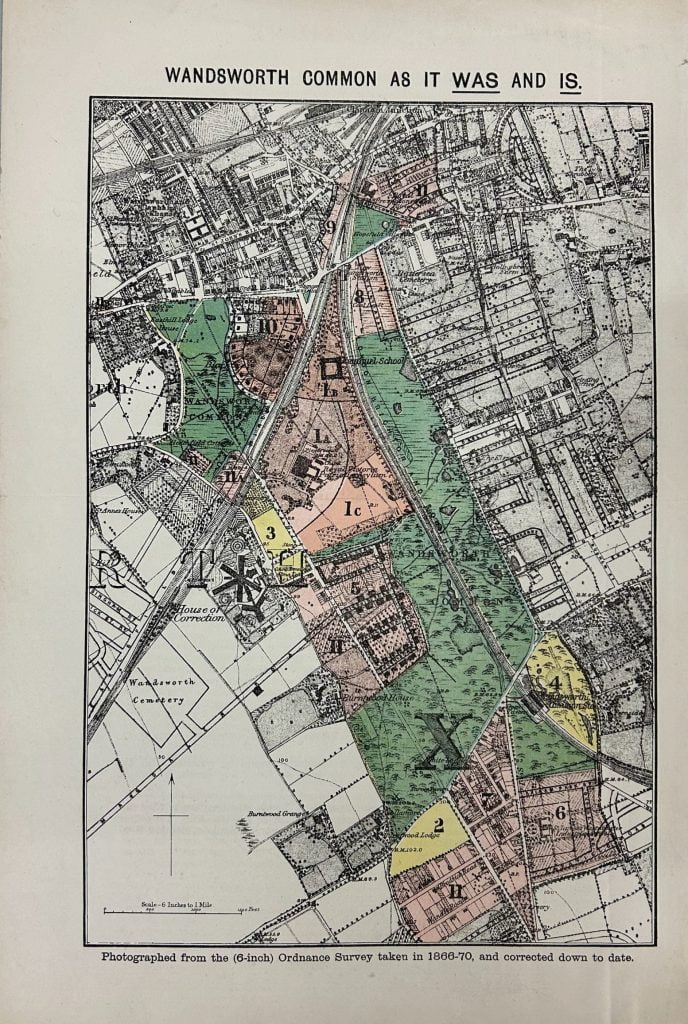
The conservators were replaced by the Metropolitan Board of Works in 1887 under The Metropolitan Board of Works (Various Powers) Bill 1887.
The Metropolitan Board of Works was ultimately succeeded by London County Council [LCC] in 1889.
The London County Council [LCC] was succeeded by the Greater London Council [GLC] in 1965 and the common passed into GLC’s care.
Finally, on the demise of the GLC, ownership of Wandsworth Common passed to Wandsworth Borough Council 1986. The Commons Act 2006 protects and safeguards public spaces, such as Wandsworth Common, for future generations.
For a really good understanding of volumes of paperwork and intensity of feeling as well as who the backers of the 1871 bill were there is a collation of the various leaflets in Magdalen College, Oxford’s archives [MP/1/99b]. They are very strangely and tightly bound and it was very difficult to image them so we apologise for the odd finger(s) appearing in image.
Read on The planning by l’Anson and building of The Toast Rack with Mr Kynock
Read on The planning and building of The Magdalen Estate with Holloway Bros

